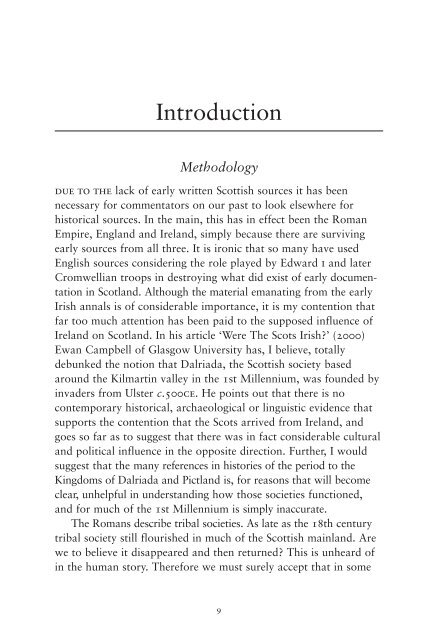Pagan Symbols of the Picts by Stuart McHardy sampler
Stuart McHardy examines the Pictish symbols which have been discovered on various items across Scotland. The book sets out a cohesive interpretation of the Pictish past, using a variety of both temporal and geographical sources. This interpretation serves as a backdrop for his analysis of the symbols themselves, providing a context for his suggestion that there was an underlying series of ideas and beliefs behind the creation of the symbols.
Stuart McHardy examines the Pictish symbols which have been discovered on various items across Scotland. The book sets out a cohesive interpretation of the Pictish past, using a variety of both temporal and geographical sources. This interpretation serves as a backdrop for his analysis of the symbols themselves, providing a context for his suggestion that there was an underlying series of ideas and beliefs behind the creation of the symbols.
You also want an ePaper? Increase the reach of your titles
YUMPU automatically turns print PDFs into web optimized ePapers that Google loves.
Introduction<br />
Methodology<br />
due to <strong>the</strong> lack <strong>of</strong> early written Scottish sources it has been<br />
necessary for commentators on our past to look elsewhere for<br />
historical sources. In <strong>the</strong> main, this has in effect been <strong>the</strong> Roman<br />
Empire, England and Ireland, simply because <strong>the</strong>re are surviving<br />
early sources from all three. It is ironic that so many have used<br />
English sources considering <strong>the</strong> role played <strong>by</strong> Edward i and later<br />
Cromwellian troops in destroying what did exist <strong>of</strong> early documen -<br />
tation in Scotland. Although <strong>the</strong> material eman ating from <strong>the</strong> early<br />
Irish annals is <strong>of</strong> considerable importance, it is my contention that<br />
far too much attention has been paid to <strong>the</strong> supposed influence <strong>of</strong><br />
Ireland on Scotland. In his article ‘Were The Scots Irish?’ (2000)<br />
Ewan Campbell <strong>of</strong> Glasgow University has, I believe, totally<br />
debunked <strong>the</strong> notion that Dalriada, <strong>the</strong> Scottish society based<br />
around <strong>the</strong> Kilmartin valley in <strong>the</strong> 1st Millennium, was founded <strong>by</strong><br />
invaders from Ulster c.500ce. He points out that <strong>the</strong>re is no<br />
contemporary historical, archaeological or linguistic evidence that<br />
supports <strong>the</strong> contention that <strong>the</strong> Scots arrived from Ireland, and<br />
goes so far as to suggest that <strong>the</strong>re was in fact considerable cultural<br />
and political influence in <strong>the</strong> opposite direction. Fur<strong>the</strong>r, I would<br />
suggest that <strong>the</strong> many references in histories <strong>of</strong> <strong>the</strong> period to <strong>the</strong><br />
Kingdoms <strong>of</strong> Dalriada and Pictland is, for reasons that will become<br />
clear, unhelpful in under stan d ing how those societies functioned,<br />
and for much <strong>of</strong> <strong>the</strong> 1st Millennium is simply inaccurate.<br />
The Romans describe tribal societies. As late as <strong>the</strong> 18th century<br />
tribal society still flourished in much <strong>of</strong> <strong>the</strong> Scottish mainland. Are<br />
we to believe it disappeared and <strong>the</strong>n returned? This is unheard <strong>of</strong><br />
in <strong>the</strong> human story. Therefore we must surely accept that in some<br />
9


















